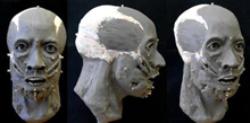Katherine Beatty
Katherine Beatty
Katherine Beatty (PhD Candidate)
Skin and Bone: The bioarchaeology of face and flesh
Supervisor: Dr. Barra Ó Donnabháin
Biological Anthropology and Bioarchaeology Research Group

| Overview |
In biological anthropology and bioarchaeology, previous scholarship into the entities of the face and flesh to have been undermined by an overshadowing emphasis of the skull (i.e. craniometry) as well as an inadequate examination into their powerfully impacting and commanding traits. Archaeology is inherently a relationship with as well as an investigation into alterity. This so being, we in the discipline must understand the demand and appeal the face imposes upon our examinations of past and present conditions.
More than components or parts that constitute the human countenance, the face is fundamentally the site of one person’s presence to another. It is the essence of the other that is always already present to the self. The special meaning of the face challenges the status of our everyday interpersonal relationships and elicits the imploring sense of responsibility for an other. I will illustrate this commanding ethical response of the face is decidedly present in the archaeological record, appearing in mortuary practices and treatment of human remains.
The ultimate goal of this research is to revitalize the entity of the face, neglected throughout bioarchaeological discourse, through the engaging and enriching contribution of 3D facial reconstructions. Additional consideration will be given to the fluctuating archaeological imagination of these productions as well as past archaeological re-presentations of the Irish countenance.
The production of three-dimensional clay facial reconstructions from archaeological skeletal material will provide the practical core of this study. Facial reconstruction (also known as facial approximation, reproduction, restoration, or restitution) is the production of the soft tissue countenance from the craniofacial skeleton. Utilising the Combination/Manchester Method, this non-destructive and non-invasive process justifiably predicts the fleshy appearance through soft tissue depths and the re-constitution of the individual’s anatomical musculature.
The collection of individuals composing the materials of this research extends through time, beginning in the Prehistoric and terminating in Post-Medieval Ireland. As well as being a diachronic data set, the reconstructed individuals also stem from a broad selection of sites across Ireland. This temporal and spatial range supports the position of the face’s universality and consistent force of impact through ages of mimetic re-production.
The forceful punctuation of the notions of face and flesh in craniofacial reconstruction shatter our sense of isolation and rupture our consideration of time and space. It is our bony landscape that dictates our fleshy appearance. I put forward that a study of this pursuit is of the utmost primacy for the nature of my inquiry into the encounter of countenance and its presence in the discipline of (bio)archaeology. Through this venture, the dynamic relationship of the face, archaeology, and peoples past and present will be exposed.
